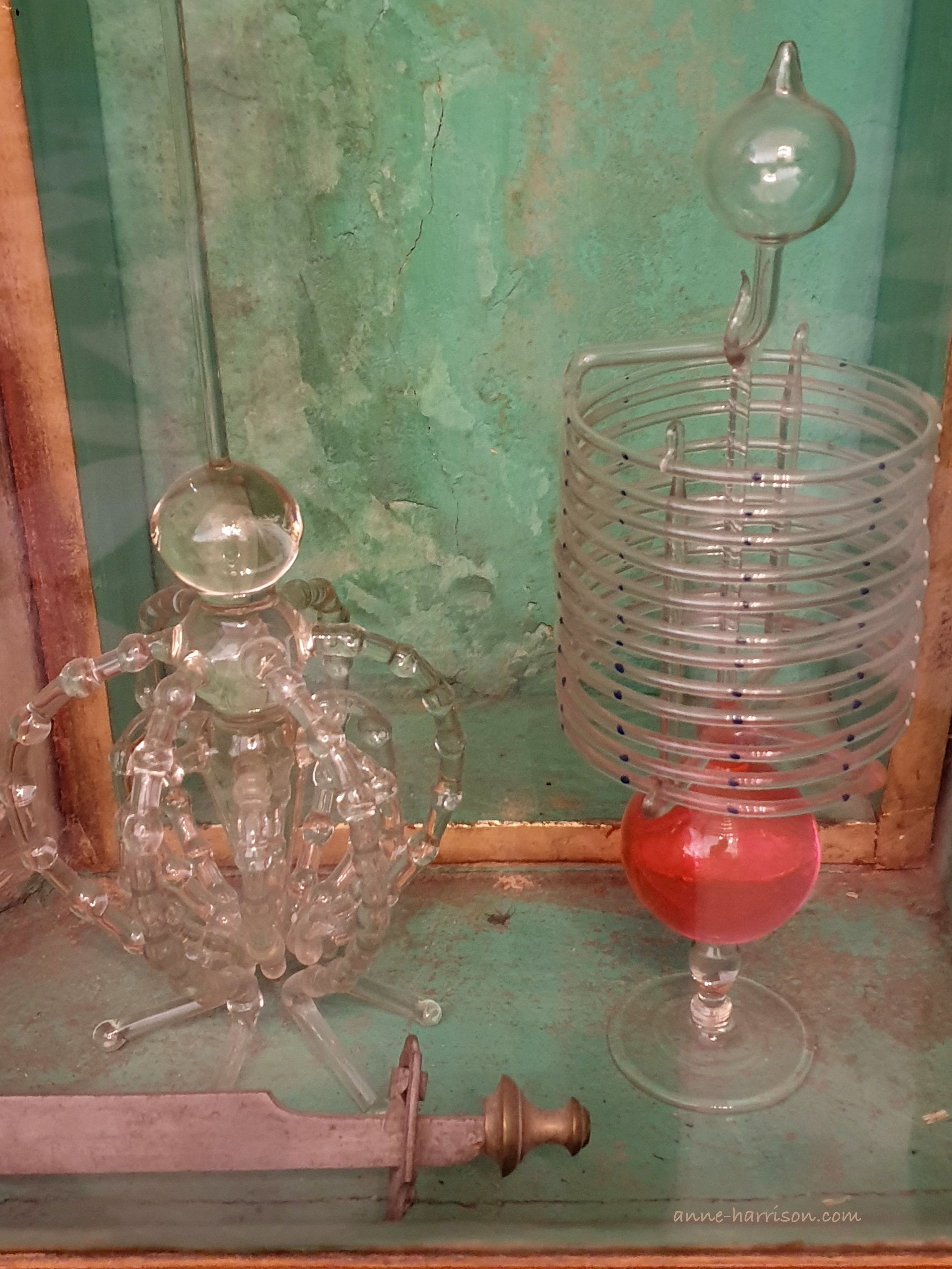The Poisons of Agatha Christie
Poppies, the eternal poison © A.Harrison
“Poison has a certain appeal,” wrote Agatha Christie in They Do It With Mirrors, “…it has not the crudeness of the revolver bullet or the blunt instrument.” Death by poison is more frequent in Christie’s world than in the works of any other mystery writer. More than thirty victims fall foul to an impressive variety of toxins (while a few lucky souls survive attempted poisonings.)
Christie’s pharmacological knowledge was extensive, a result of her work as both a nurse and a pharmacy dispenser during both World Wars. (Perhaps this is why physicians often make an appearance as murders in her novels.)
Strychnine is used in Christie’s first who-dunnit, The Mysterious Affair at Styles. For a writer, strychnine is an ideal poison, being easily absorbed with a rapid onset of action, and its effects are impressively dramatic. An alkaloid derived from the seeds of the tree Strychnos nux vomica, strychnine works as a competitive antagonist of glycine, an important inhibitory neurotransmitter. Strychnine blocks motor neuron post-synaptic receptors in the spinal cord’s central horn, antagonizing inhibitory tone. Uncontrollable muscle contractions result, classically beginning with trismus and risus sardonicus, then spreading distally, with increasing frequency and intensity. Death occurs some two — three hours after exposure, most commonly from respiratory failure compounded by lactic acidosis and rhabdomyalysis.
Cyanide is the poison Christie used most often to dispatch her victims, (followed by arsenic, strychnine, digitalis then morphine). Cyanide is derived from the seeds of the Prunus family, (which includes cherries, apricots and almonds) and is rapidly lethal. It works as a mitochondrial toxin, inhibiting cytochrome c oxidase in the electron transport chain, thus preventing cells from aerobically using adenosine triphosphate for energy. High concentrations leads to death in minutes; the cyanide-haemoglobin complex can cause the skin to remain pink (in contrast to the cherry-red of carbon-monoxide poisoning), despite cellular hypoxia.
Chronic ingestion causes a variety of symptoms ranging from generalised weakness, confusion and bizarre behaviour, through to paralysis and liver failure. Cyanide features in The Mirror Crack’d from Side to Side, And Then There Were None, A Pocketful of Rye and, of course, Sparkling Cyanide .
Arsenic, once favoured by the Borgias, makes an appearance in 4.50 From Paddington. A tasteless, odourless white powder, arsenic is minimally soluble in cold water but readily dissolves in hot fluids — such as tea or coffee. Arsenic interferes with cellular longevity by inhibiting the pyruvate dehydrogenase complex, resulting in cellular apoptosis. Acute exposure generally manifests with watery diarrhoea, causing dehydration and hypovolaemic shock. Lactic acidosis and hypokalaemia can also occur. Arrhythmias include QT prolongation and ventricular fibrillation.
Chronic toxicity is more insidious, with the clinical effects dependent upon the length of exposure. Hyperkeratosis and Mees lines on the nails are classical, as is a painful, glove-and-stocking paraesthesia. Hepatic and renal impairment may also result, and a patient’s breath often has a garlic smell.
Death on a white horse © A.Harrison
In The Pale Horse, the murderer uses a coven of witches to curse victims, thus masking deaths due to thallium (a common rat poison at the time). Thallium can be absorbed topically, ingested or inhaled, is colourless and tasteless, dissolves in water, and has a slow onset of vague symptoms. The first signs are usually vomiting then diarrhoea, followed by a range of neurological symptoms. A fatal cardiac toxicity occurs some three weeks after adequate exposure. Hair loss is also common — it is this which first triggers suspicion in The Pale Horse.
Coffee - perfect for masking bitter flavours © A.Harrison
In A Pocketful of Rye, marmalade is laced with taxine. (The murderer later puts cyanide in another victim’s tea.) Derived from the leaves of the English yew tree, taxine has a bitter taste. By disrupting microtubular function, it inhibits cell division. Death can be so rapid, however, that the common signs of a staggering gait, seizures, respiratory failure and heart failure may be missed. Most parts of the tree are toxic (save the aril surrounding the seeds, which allows distribution of the seeds by birds without them being poisoned).
In Five Little Pigs, the painter Amyas Crale is murdered with coniine. An alkaloid extracted from hemlock, coniine works peripherally as a neurotoxin, causing death by respiratory paralysis. Less than two hundred micrograms is fatal; Socrates consumed hemlock when condemned to death in 399 BC for corrupting the youth of Athens.
In Cards On The Table, a doctor murders his victim by contaminating his shaving brush with bacillus anthracis, knowing the bacillus will pass transcutaneously through any nicks made by the razor. In Dumb Witness, the victim’s liver pills are doctored with phosphorous. The hint is given by the ‘aura’ seen around the woman: the phosphoresence of her breath. Exposure can also lead to ‘phossy jaw’, a severe necrosis common in workers in match factories, where white phosphorous was an early component. Severe liver damage can also result.
Monkshood dispatches several victims in 4.50 From Paddington. Described by the Roman naturalist Plinius as ‘plant arsenic’, it was once used to coat spears, prior to hunting panthers and wolves. It was also reputed to also kill werewolves, (although other sources claim a brew will prolong the lycanthropic condition when a werewolf is under the influence of the full moon). The active component is aconitine, which causes salivation, followed by vomiting, diarrhoea, respiratory failure and cardiac arrest.
Belladonna (also known as Deadly Nightshade, Devil’s Berries or Death Cherries) features in The Caribbean Mystery and The Big Four. Both the foliage and berries are toxic, containing a mixture of alkaloids including hyoscine (scopolamine) and atropine (both anti-cholinergic anti-muscurinic in action) and hyoscyamine (an isomer of atropine). Both the Emperor Augustus and Agrippina (wife and sister of Claudius) used belladonna to poison contemporaries. Symptoms include dilated pupils, blurred vision, tachycardia, dry mouth, slurred speech, urinary retention, confusion and hallucinations.
Elegant but antiquated pharmacy equipment © A.Harrison
The anti-dote for belladonna poisoning is physostigmine, which is itself used as a poison in Crooked House, where it is administered via eye drops. Derived from the West African calabar bean, physostigmine is a cholinesterase inhibitor, reversibly blocking the action of acetylcholinesterase in the synaptic cleft of the neuromuscular junction. Overdose results in the cholinergic syndrome, due to central and peripheral increase of acetylcholine at muscurinic and nicotinic receptors.
Morphine is another poison favoured by Christie. In Sad Cypress, morphine is administered through (it is first thought) fish paste on sandwiches. The arsenic is instead served in a pot of tea, the murderer also drinking from the pot to ally suspicion, then surreptitiously self-administrating an emetic. In Death Comes As The End, (set in Ancient Egypt), the poison added to the wine which kills Sobek is never discovered, but assumed to be the juice of the poppy. (The priest-physician tests the remaining wine on animals, all of which rapidly succumb.) The matriarch Esa meets her death by means of an unguent made of poisoned wool fat.
Murder mysteries would be incomplete without the use of sleeping tablets. In Lord Edgware Dies, Carlotta Adams meets her end due to an overdose of veronal. The first commercially available barbiturate, veronal had a slightly bitter taste, and a therapeutic dose far below the toxic dose. However, tolerance occurred with chronic use, requiring higher doses for effect, and fatal overdoses, either accidental or intentional, were not infrequent.
Curtain, in which Poirot makes his final appearance, is a lesson in polypharmacy. (Poirot is the only fictional character to have been given an obituary in The Times.) Freda Clay poisons her aunt with morphine; Barbara Franklin is poisoned with physostigmine. Poirot drugs Hasting’s hot chocolate with sleeping tablets (unnamed, but possibly veronal) to prevent him committing murder; Mrs Franklin chooses the wrong coffee cup and dies from the poison she had added to kill her own husband; Poirot laces two cups of coffee with his sleeping tablets, so drugging Norton (who, suspecting, chooses Poirot’s cup) but not himself, as he is tolerant to the tablets. After shooting Norton, Poirot himself dies, not by poison, but by its absence: with terminal heart disease, the famous Belgian places his supply of amyl nitrate out of reach, thus ensuring his own death during the night.
Agatha Christie’s writing reflects that period of English life from the end of WWI to well after the Second World War. Despite the changing social mores, human nature is constant, and her writing offers an historical-social insight into this time. Most of the poisons used by her murderers were readily available, sometimes through their work, but more often to be found under the kitchen sink, or growing amongst the beauty of an English country garden.
This was first published many moons ago under my professional name Dr Anne Gunner in a medical journal which is no longer in circulation.
Classical gardens - filled with potential poisons © A.Harrison
Enjoy my writing? Please subscribe here to follow my blog. Or perhaps you’d like to buy me a coffee? (Or a pony?)
If you like my photos please click either here or on the link in my header to buy (or simply browse) my photos. Or else, please click here to buy either my poetry or novel ebooks. I even have a YouTube channel. Thank you!
Plus, this post may contain affiliate links, from which I (potentially) earn a small commission.






